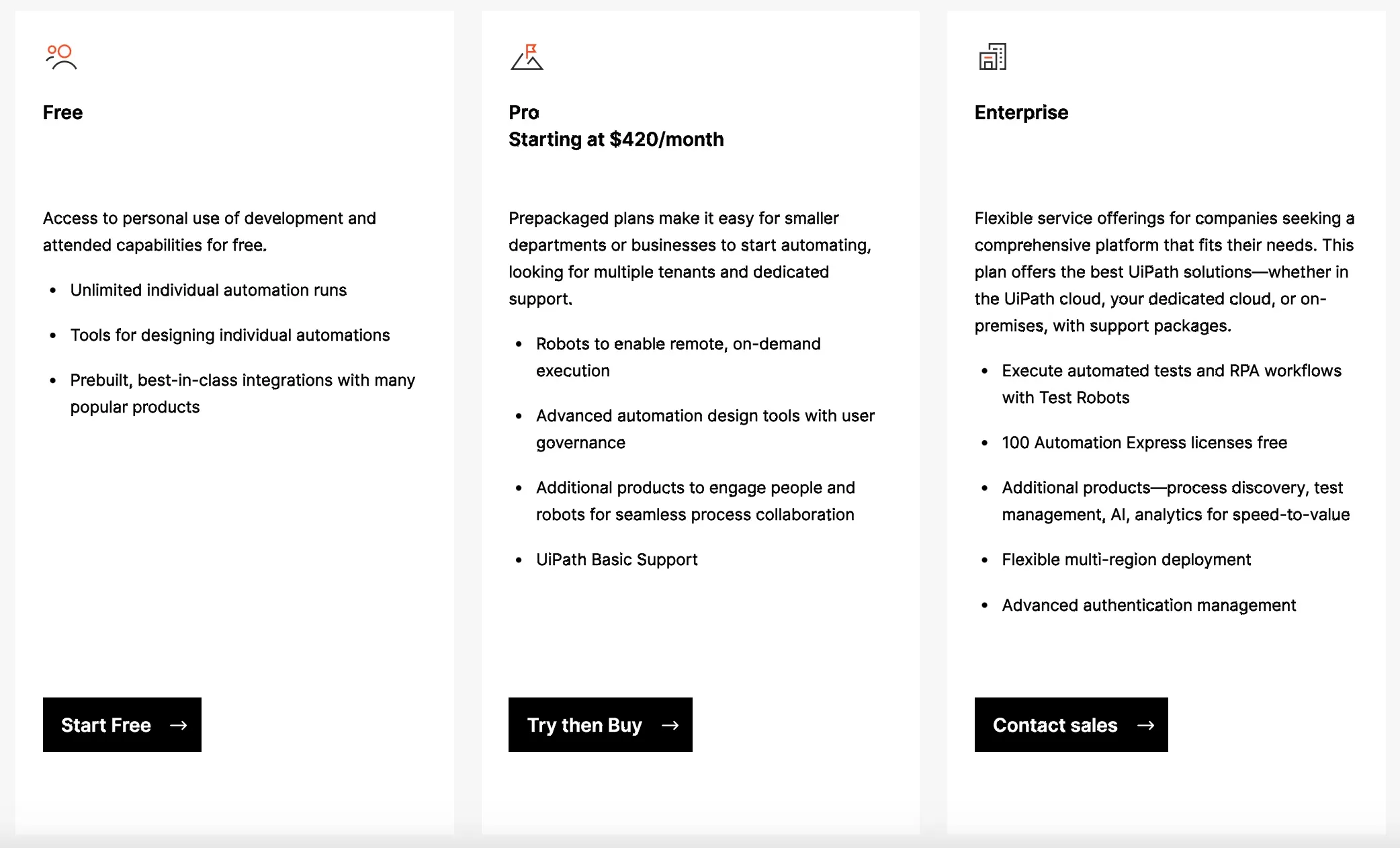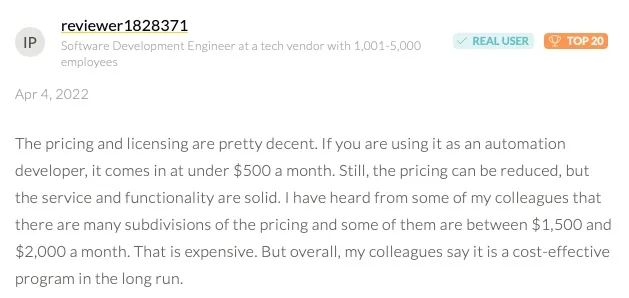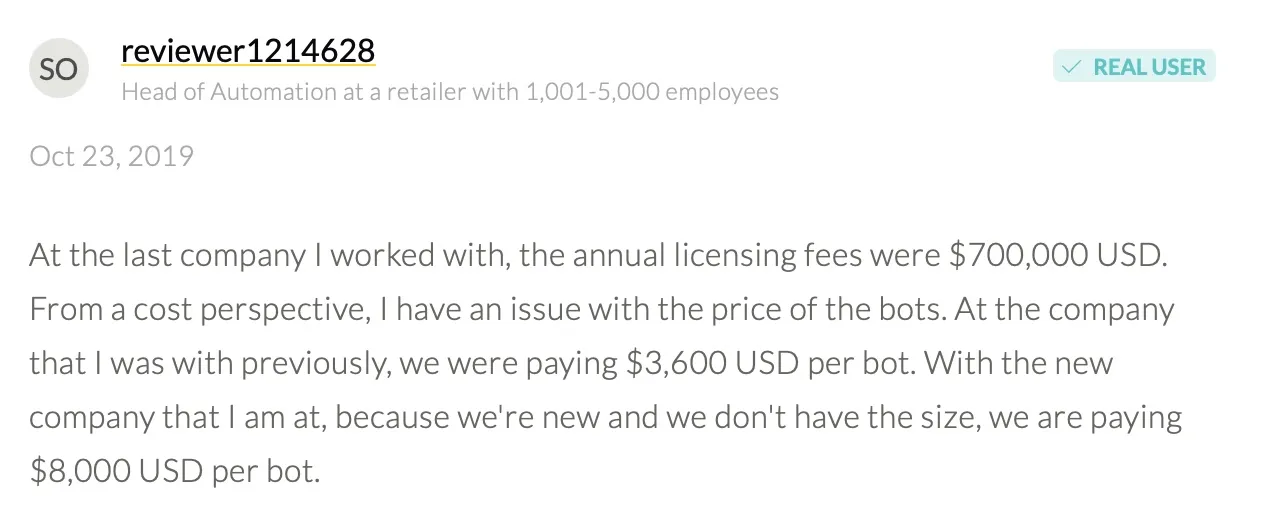



Take a self-guided tour of the platform.
See why Vertice is trusted by top procurement leaders.



RPA software giant, UiPath, has recently been inducted into the coveted ring of unicorn companies, valued at over $1 billion. Its hero automation platform helps organizations automate repetitive tasks and streamline operations — making it a must-have tool for many in the age of digital transformation.As a result, UiPath now features in the tech stacks of more than 10,000 companies worldwide and has earned itself an almost five-star rating on G2, making it a platform worthy of consideration.But while there are many considerations to make before purchasing any new software application, cost still very much drives the decision. Especially given how SaaS prices are continuing to spiral.So, the question is, just how much does UiPath cost? And is it possible to get a UiPath discount?Here’s everything you need to know.,
How much does UiPath cost?
UiPath offers several different plan tiers to accommodate varying budgets and usage needs. According to the vendor’s pricing page, this includes a free iteration of the platform, a paid plan starting at $420 per month, and a quote-based enterprise-level subscription.But even when a vendor opts to publicly list some of its price points, this doesn’t necessarily mean that what’s posted online is set in stone.In other words, there is almost always an opportunity to negotiate a discounted price.But before you explore how much you could save, you need to familiarize yourself with the pricing plans on offer — this way, you can approach negotiations with a clear understanding of the solution you require.
UiPath pricing plans
Each UiPath plan offers a different level of functionality and license allotment for tools within the platform (attended bots, unattended bots, development robots etc.).Here’s an overview of the tiers on offer:,

, FreeThe free version of UiPath offers basic access to the platform’s core features, recommended for personal use and developmental experimentation. Users can enjoy an unlimited number of individual automation runs, access to basic services like UiPath Orchestrator, and 25 free licenses to leverage attended robots.ProUiPath’s standard paid plan is called Pro, which offers a 60-day free trial, after which users will have to pay to upgrade to a full plan. Pro licenses cost $420 per month, increasing with the purchase of add-ons. This tier offers all features from the free plan as well as more advanced functionality like access to the UiPath automation studio, AI Center, unattended robots and more.UiPath Enterprise pricingThe enterprise-level UiPath plan is recommended for companies seeking a comprehensive pricing package tailored to their specific usage needs. As well as the full functionality from Pro, UiPath Enterprise enables users to access the UiPath test manager, execute automated tests, deploy RPA workflows, manage authentication and deploy in multiple regions, and it includes 100 free Automation Express licenses out of the box.If you’re working with automations at scale, UiPath Enterprise might be the plan for you. However, as is the norm for SaaS vendors, UiPath opts to obscure its enterprise-level pricing information. So, while we can safely assume that the starting price will be higher than that of a Pro plan, how can we find out precisely what UiPath Enterprise costs?One way is to scour threads and articles on the internet for information about what other companies pay. This way, you’ll be able to inspect whether your budget will accommodate an enterprise-level plan more closely — and if you’ve already been quoted a price, how yours stacks up against your peers.
Searching online for pricing insights
This approach can provide a useful ballpark for how much you should expect to pay for a subscription. However, the issue is that it doesn’t always yield concrete figures. In fact, depending on where you look, the information you find can be quite contradictory.For example, one user on this PeerSpot thread says that their colleagues pay between $1,500 and $2,000 per month.,

, Elsewhere on the same thread, however, users tell of UiPath bills that have racked up vastly different costs. One says $40,000 in annual fees, another $90,000 — and one contributor even writes that their last organization paid $700,000 for the solution in just one year.,

, So, the information that you’ll find searching online is contradictory, to say the least.The question is, are there any other reliable ways to find out how much other organizations are paying for UiPath?Looking a little deeper, we found one article from The RPA Software Blog that placed the average subscription cost for UiPath at approximately $66,000 per year. This figure seems to corroborate some accounts from the PeerSpot thread, but ultimately, it still comes from an unverified and potentially outdated source.All in, these findings rather aptly sum up the issue of pricing transparency in SaaS. While following a quote-based model can help providers attain bespoke, needs-based pricing, it leaves the buyer with the challenge of figuring out if they’re getting a good deal or not.So, how else can you find out the cost of UiPath without entering into a sales conversation with the vendor?In short, you’ll need Vertice. We have access to the pricing and discounting data from over 16,000 SaaS vendors — UiPath included. But we’ll get onto that shortly., , , ,
Can you get a discount on UiPath pricing?
Needless to say, UiPath pricing is a little complex to get your head around — but now that you have a basic understanding of the kinds of plans available, is it possible to get a discount on pricing?We’ve found that software prices are rarely set in stone, even if listed. Our data shows that UiPath is fairly consistent in the pricing offered to different buyers, but it’s by no means perfect — and buyers have a medium possibility of receiving a discounted rate.But just how do you go about securing one?This will all depend on your software negotiation strategy. Here are our top recommendations for productive software negotiation.,
Tips to successfully negotiate a UiPath subscription
Sign up for a longer subscription periodAs your organization scales, it can be difficult to reliably anticipate your future software needs. However, if you’ve reached a point of stable growth, it may be productive to suggest a longer commitment period when negotiating with software vendors. With the offer of repeat custom on the table, vendors are usually more amenable to discounted terms.In fact, our data shows that software providers offer an average 5% discount for each extra year that a user subscribes. So, proposing an annual or even a multi-year subscription could yield significant cost savings across UiPath and any other contracts that you’re purchasing or renewing., Software providers typically offer an extra 5% discount for each additional year that a user subscribes to., Leverage pricing benchmarksAs we’ve discussed, it can be challenging to source reliable intel on what other UiPath subscribers pay for their contracts. However, this data provides powerful negotiation leverage, with vendors known to offer or match discounted price points secured by other customers.But to get the best results, you can’t just use any old data — especially considering how contradictory some of the figures can be. Instead, you’ll want to talk to Vertice for reliable price benchmarking data.,
Let Vertice negotiate a deal on your behalf
With access to the transactional data from over 16,000 global SaaS vendors, UiPath included, we’re equipped to negotiate best-in-class software deals on your behalf. Our experienced software purchasing team can handle the entire process, saving you the time and energy put toward efficiently procuring SaaS solutions.When you work with a SaaS procurement partner like Vertice, you ultimately ensure that both you and the vendor walk away with a deal you’re happy with. All communication happens between us and the vendor, relaying your needs and creating a level playing field for negotiations.With the average company overpaying for software by up to 30%, why not see how much you could be looking to save on your annual software spend. Alternatively, have a read how Vertice helped one company save $170,000 on a single SaaS contract and achieve ROI through savings in just three days.,

, , , , , , , , , , , , , , , , , , , , , , , , , , , , , , ,
.webp)















